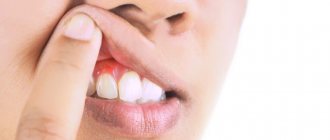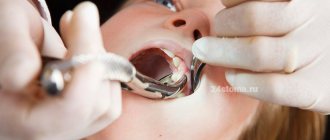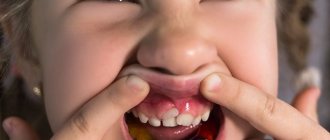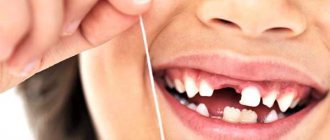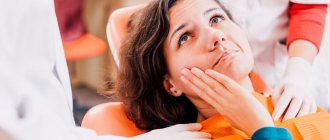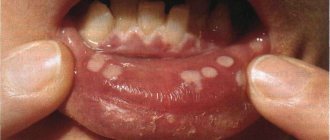If a child has a loose permanent tooth, believe me, he will touch it with his hands and tongue until it falls out. But don't worry, everything can be fixed.
The treatment of young patients at Idealdent is developing on a par with adult dentistry. We treat children's teeth gently and with care for psychological comfort. At the end of each appointment we give a small gift so that going to the doctor is perceived as an adventure.
Reasons why pathological loosening of teeth is possible
Mobility of a child's permanent teeth is an alarming sign and may indicate diseases of the oral cavity and pathology of internal organs.
Most often, loosening of permanent (molar) teeth occurs when:
- periodontitis;
- caries;
- inflammatory processes of the gums;
- injuries;
- metabolic disorders;
- systemic diseases.
If your child has complaints about a loose molar, contact your dentist immediately.
In the occurrence of such a problem, a hereditary predisposition plays a certain role, due to which the tooth root is poorly fixed in the jaw tissues. This can be facilitated by early tooth loss among close relatives in the same family.
Let's look at each of the reasons in more detail.
A 5-year-old child has loose baby teeth: what to do?
What to do if a child’s baby tooth is very loose?
The question is relevant for parents of children 5-6 years old. During this period, the bite begins to change, and the milk units acquire increased mobility. The process is natural, and in its normal course does not cause any inconvenience to the child. The period of spontaneous loss depends on many factors and takes from 3-4 days to a couple of months. Often, adults and children lose patience and try to remove a changing tooth on their own - by pulling it out with a thread, by hand, or by including obviously hard foods in the menu. Dentists do not advise overdoing it. Why you shouldn’t help change your bite when a 5.5-year-old child’s teeth are loose:
- The first milk teeth should be replaced on their own - in the absence of pathologies and normal growth of new teeth.
- Healthy primary teeth provide the correct environment in the mouth for growth and bite development.
- Baby teeth are gradually preparing for the eruption of molars - the roots must dissolve, and the new crown will prepare to emerge from the gums.
Interference with the natural process is fraught with dental problems - malocclusion, teeth growing in a “checkerboard” pattern. But these same problems are also possible with an unsupervised shift, so parents should monitor the child’s condition and, if problems arise, contact pediatric dentists.
Rodikova Tatyana
“Often parents themselves try to remove a loose baby tooth from their child. This can only be done if the baby is not afraid and the tooth itself is very mobile. Of course, we must not forget about sterility and cleanliness, otherwise the consequences of removal will take a long time to heal. But the best option is to entrust the procedure to a doctor. He will do it faster, more professionally, without pain and without scaring the child!”
Periodontitis
Most often, periodontitis is observed in 9-10 year old children. Although this pathology occurs only in 3-5% of children, it is the most common cause of pathological loosening of teeth in children. The peculiarity of this pathology is that it damages functionally immature tissues, which can contribute to rapid tooth loss.
Periodontitis can most often occur through failure to maintain sufficient oral hygiene, as well as the accumulation of food debris and plaque on the teeth, which become a place where bacteria multiply. In addition, the inflammatory process in periodontal tissues can develop due to the habit of biting food on one side, as well as a lack of dense foods in the diet, due to which the teeth cannot receive sufficient chewing load.
Causes
The mobility of permanent teeth in a child is an alarming sign and indicates both diseases in the oral cavity and possible problems with internal organs.
The most common causes of loose molars can be:
- periodontitis;
- inflammatory gum diseases;
- caries;
- systemic diseases and metabolic disorders;
- injuries.
Hereditary predisposition also plays a certain role in the development of this pathology, as a result of which the tooth root is poorly fixed in the tissues of the jaw. This reason may be supported by cases of detection of early tooth loss in one family among close relatives.
Let's look at each of the reasons in more detail.
Periodontitis
Periodontitis most often occurs between the ages of 9 and 10 years. And although this disease occurs in only 3-5% of children, it is the main cause of pathological loosening of teeth in childhood. The peculiarity of this pathology is that it affects functionally immature tissues, which can quickly lead to tooth loss.
Most often, periodontitis occurs due to poor oral hygiene and the accumulation of plaque and food debris on the teeth, which become a breeding ground for bacteria. Also, inflammation of periodontal tissue can occur if there is a habit of biting food on only one side or with a lack of dense foods in the child’s diet, as a result of which the teeth do not receive the necessary chewing load.
Inflammatory gum diseases
The most common pathology is gingivitis, which appears if dental plaque is not completely removed during brushing, when the body’s immune defense is weakened, after infectious diseases, or when the child’s diet lacks essential vitamins and minerals. A characteristic sign of inflammation in the gums is their bleeding while brushing your teeth or eating. Without treatment, gingivitis is often complicated by loosening of teeth and subsequent loss of teeth.
Caries
In children, caries is characterized by a high rate of development and deep tissue damage, even with a small visible defect. Since after eruption, the child’s molars do not have mature enamel, and the process of its formation still continues for several years, it is during this period that the most dangerous period is for the development of carious cavities.
Sometimes forms of caries occur in which the invisible part of the tooth is affected. And they are discovered only after the tooth begins to wobble.
General diseases of the body
Systemic diseases accompanied by impaired blood supply to tissues and metabolic pathologies can also lead to loose teeth in children and adolescents.
Such diseases include:
- psoriasis;
- diabetes;
- thyroid diseases;
- hereditary pathology of connective tissue.
With this pathology, blood microcirculation in the periodontium is disrupted, as a result of which the tissues do not receive the required amount of nutrients and oxygen. Dystrophic processes begin, which lead to a weakening of the connection with dental tissues - the child’s tooth begins to wobble.
Injuries
Children are characterized by great mobility, due to which injuries and falls often occur. At the same time, the immaturity of dental tissue makes it very fragile and brittle. It is not uncommon for a child to hit his face during a fall and knock out his front tooth. Also, after an impact, breaks and fractures of the teeth may occur, which will be manifested by their pathological mobility.
Sometimes the habit of chewing hard objects or grinding their teeth can lead to dental injury in children.
Inflammatory gum disease (gingivitis)
The most common pathology is gingivitis, which occurs when dental plaque is not completely removed when brushing teeth, after infectious diseases, when the immune system is weakened and the baby’s diet lacks the necessary vitamins and microelements.
A characteristic sign indicating inflammation in the gums is their bleeding when eating or brushing teeth. Gingivitis without proper treatment can be complicated by loosening of teeth and their loss in the future.
Removal of the first teeth
Often, when removing a baby tooth that has already begun to loosen, anesthesia is not required. In such cases, the presence of a dentist is not always necessary - the baby will be able to cope with the task himself. You can only help him a little - provide hard vegetables and fruits, such as carrots or apples, as loosening materials. If, after a tooth falls out, bleeding begins, it can be stopped using a cotton swab with chlorhexidine or another safe antiseptic. If the baby throws a whole tantrum, cannot pull out a tooth on his own and is not given to his parents, then it is better to use the services of professionals - they will help the baby quietly and without pain. The main mistake parents make is often their own panic, which is passed on to the child. In this case, on the contrary, they need to support their child - use as an example one of the children they know who has already had their teeth pulled out, or praise the baby for his heroism. In any case, the support of relatives in the dental chair will be invaluable for the child.
Caries
Caries in childhood is characterized by a high rate of development, as well as damage deep into the tissue, even with a minor visible defect. Since there is no mature enamel on the molars of babies after eruption, and its formation continues for several years, it is during this period that carious cavities most often develop.
Sometimes caries can occur in which the invisible part of the tooth is damaged. It is most often possible to detect it already when the tooth is loose.
General diseases of the body
The loosening of teeth in childhood and adolescence is promoted by systemic diseases, which are accompanied by metabolic disorders and blood supply to tissues.
This pathology includes:
- pathology of the thyroid gland;
- diabetes;
- hereditary connective tissue diseases;
- psoriasis.
With such diseases in the periodontium, blood microcirculation is disrupted, which is why the required amount of oxygen and nutrients does not reach the tissues. Dystrophy begins, as a result of which the connection with dental tissues is weakened and the baby’s tooth begins to wobble.
When a child’s tooth hurts and is loose: what to do
Pain is evidence that some processes in the child’s body are disrupted. Even when it comes to such a simple thing as a change in bite, pain should not be ignored. A dental consultation is indicated in the following cases:
- During an early shift. Renewal of the bite begins at 5-6 years old, but what to do when a baby tooth in a 3-4 year old child is loose. Early change of dental units can lead to deformation of the dentition and abnormal development of the bite. A baby’s swaying tooth is a reason to see a doctor. In this case, the orthodontist will save space for the new unit, and the child’s adult bite will form normally.
- Prolonged period of loss of baby teeth. When a tooth is completely crooked, it hurts, but does not fall out, the doctor must definitely examine the child. The reasons for the delay can be very different - from improperly absorbed roots to gum disease.
- Deterioration in the general well-being of the young patient. Fever, weakness and nausea are signs of inflammation. The doctor will determine the cause of the problem and suggest the right solution.
- Change in mobility. When the front baby tooth of a 5-year-old child becomes loose, and then stops, it’s a reason to examine the gums. Redness, swelling and pain are possible causes of inflammation of the gums and periodontal tissues.
During the consultation, the doctor will examine the condition of the child’s oral cavity and select the optimal treatment. This may include preservation of the tooth, removal under sedation, and recommendations for care to alleviate the condition.
Plaksina Margarita
Sedation in dentistry is a modern, comfortable anesthesia. The child is put into a half-sleep and asked to breathe “laughing” gas through a mask. The mixture supplied - nitrous oxide and oxygen - has a relaxing effect: it relieves anxiety, panic, but leaves consciousness. The baby understands everything, but is not afraid at all. This allows you to carefully remove a loose tooth without any discomfort.
Treatment
If a child’s molar hurts and is loose, this is a mandatory signal that he needs to go to the dentist. Only a good specialist will answer the question of whether there is a chance to save the tooth and what needs to be done for this. Due to delay, the tooth may fall out, and this can provoke negative consequences in the future.
If the tooth begins to become loose due to gingivitis or periodontitis, then you need to carry out a professional cleaning procedure to remove plaque and prescribe a course of anti-inflammatory treatment. In some cases, this involves splinting the teeth to prevent them from loosening in the future.
In the case of traumatic injury, the dentist decides whether to save the damaged tooth or not depending on the individual case. If possible, the maximum amount of dental tissue is preserved, because during prosthetics they can become the necessary support.
If the cause of loosening is caries, then the specialist assesses how damaged the dense dental tissues are and whether the molar can be saved. It is removed only in extreme cases when conservative treatment is not possible. If, in the presence of a carious cavity, the necessary treatment can be carried out, then the damaged tooth is filled.
If a tooth begins to loosen due to systemic diseases, then not only the dentist, but also an endocrinologist, pediatrician and other specialists are involved in the treatment of this problem.
Injuries
Many children find it impossible to sit still. And some of them sometimes fall. If the injury occurs in the vicinity of the jaws, the teeth may also suffer. There are often cases where a child knocked out one or even two or three teeth during a fall. But tooth fractures are not always open - cracks and root fractures can also occur - the tooth tilts to the side, and accordingly, it immediately begins to wobble.
Dental injuries also appear when a child suffers from bruxism (grinding his teeth in his sleep), or tried to chew, for example, a candy that was too hard, or, for example, got a stone in the cereal from which the porridge was cooked.
Prevention
In order to preserve the beauty of your smile and healthy teeth for many years, you need to take care of this from childhood. Parents must monitor their child’s hygiene procedures and be sure to visit the dentist at least 2 times a year. Diet is very important. If there is the slightest suspicion of a problem, you should immediately contact your dentist.
Add a review (comment)
By submitting this form you accept the privacy policy.
What to do
If your front tooth begins to loosen for no apparent reason, you should clearly understand that inaction can lead to its loss. Initially, it is necessary to identify the cause of the disease in order to take the necessary measures to eliminate it. But it is almost impossible to independently identify the cause and make a correct diagnosis, so it is extremely important to seek the help of a specialist. Quite often, loose teeth are a consequence of bad habits, such as drinking alcohol and smoking. There are also hereditary causes of this process. People with malocclusion often have loose front teeth. In such situations, treatment should be carried out by a qualified orthodontist.
